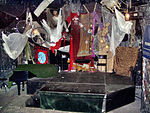Historical Museum of Kraków
1899 establishments in Austria-Hungary1899 establishments in PolandArt museums and galleries in PolandHistory museums in PolandMuseums established in 1899 ... and 3 more
Museums in KrakówPalaces in PolandRegistered museums in Poland

The Historical Museum of the City of Kraków (Polish: Muzeum Historyczne Miasta Krakowa) in Kraków, Lesser Poland, was granted the status of an independent institution in 1945. Originally, it was a branch of the Old Records Office of Kraków, in operation from 1899.The Museum's main location is the baroque Krzysztofory Palace.
Excerpt from the Wikipedia article Historical Museum of Kraków (License: CC BY-SA 3.0, Authors, Images).Historical Museum of Kraków
Main Square, Krakow Stare Miasto (Old Town)
Geographical coordinates (GPS) Address Nearby Places Show on map
Geographical coordinates (GPS)
| Latitude | Longitude |
|---|---|
| N 50.0625 ° | E 19.936389 ° |
Address
Pałac Spiski
Main Square 34
31-008 Krakow, Stare Miasto (Old Town)
Lesser Poland Voivodeship, Poland
Open on Google Maps










